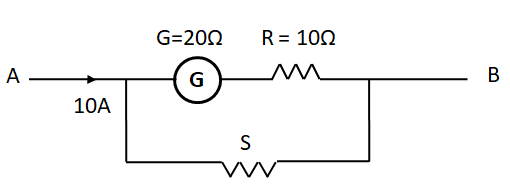Question
Question: Full scale deflection for a galvanometer is \(1{\text{mA}}\). The value of shunt resistance (approxi...
Full scale deflection for a galvanometer is 1mA. The value of shunt resistance (approximately) so that galvanometer shows half scale deflection is

(A) 1.5mΩ
(B) 3mΩ
(C) 10mΩ
(D) 15mΩ
Solution
Hint
To solve this question, we have to find out the current through the galvanometer, which is equal to half of the full scale deflection current. Then, using KCL and KVL in the given circuit will give the required value of the shunt resistance.
Complete step by step answer
It is given that the full scale deflection current for the galvanometer is Ig=1mA
Now, according to the question, the galvanometer should show half scale deflection, which means that the current which passes through the galvanometer in this case is
⇒I=2Ig
⇒I=21mA=0.5mA
Converting in amperes, we get
⇒I=0.5×10−3A
So, the current distribution in the circuit is as shown in the below diagram.

Here IS is the current flowing through the shunt resistance. Here the current of 10A is divided among the two branches, one branch containing the galvanometer and the series resistance, and the other containing the shunt resistance. Applying KCL at the point of division of current, we get
⇒10A=0.5mA+Is
⇒Is=10A−0.5mA
As 0.5mA current is negligibly small as compared to the current of 10A, so we approximate the current through the shunt resistance as
⇒Is≈10A
Now, as the shunt resistance is connected parallel to the serial combination of the galvanometer and the series resistance, so the potential difference across them will be equal. This gives
⇒IS(S)=I(G+R)
⇒10(S)=0.5×10−3(G+R)
According to the question, G=20Ω and R=10Ω
⇒10(S)=0.5×10−3(20+10)
On simplifying, we get
⇒S=1.5×10−3Ω
⇒S=1.5mΩ
Thus, the shunt resistance is equal to 1.5mΩ.
Hence, the correct answer is option (A).
Note
While approximating the current through the shunt resistance as the original current, do not take the current through the galvanometer equal to zero, although applying KCL will give it equal to zero. We have to take care of the fact that the galvanometer is a very much sensitive device. So it shows the deflection even for a negligibly small amount of current which flows through it. Hence, even the negligibly small value can’t be neglected for a galvanometer.
